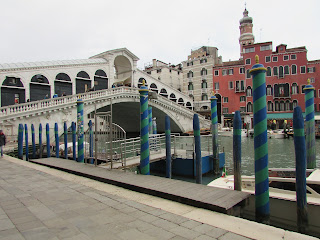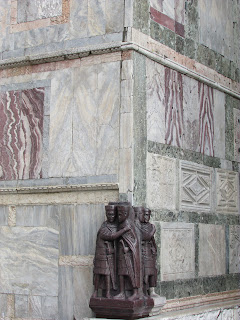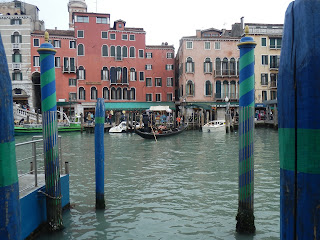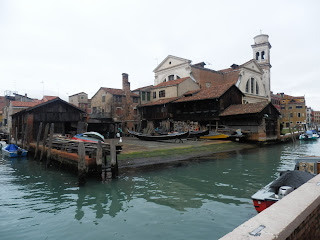Having visited Venice on a previous occasion by train, I was recently informed that the only way to properly arrive in the city of canals was by water. On this occasion I chose to take the advice and took the Alilaguna water taxi from Marco Polo airport, and now stand corrected. Entry to Venice by water was definately better and much more thrilling. Arriving on the crest of a wave was certainly a dramatic and fitting entry to a city founded on water. It was really exciting to be buffeted by the wake of other boats ploughing through the waves of the lagoon. We made slow but steady progress cutting through the surf, all the while gradually nearing the floating city. Before we knew it we were turning into the shelter, relative quiet, and grandeur of the Grand Canal and Venice proper.
The city is ridiculously photogenic, and these are the views from the balcony of the hotel I stayed at directly on the Grand Canal, which was quite fittingly, the erstwhile palazzo estate of an artist.
Just opposite was the picturesque museum - the Ca d'Oro, one of the finest examples of Venetian Gothic architecture to be found in the city. It was absolutely beautiful with its façade of carved ogee windows, oriental finials and marble tracery.
Eager to explore the city afresh, I headed out into the very narrow, pressing medieval streets to negotiate Venice's numerous bridges and canal waterways. It was initially strange to be in a car free environment, but with this came a real sense of relaxation.
I used the Grand Canal as a means of finding my bearings, and within a few minutes of wandering, noticed this huge, very striking sculpture by Lorenzo Quinn (son of actor Anthony Quinn), entitled Support, installed at the Ca’ Sagredo Hotel and designed to highlight climate change.
A few steps further and I found that I had arrived at the Rialto Markets and the famous Pescheria fish market. The design of the building included some fittingly fishy architectural ornamentation.
The freshly displayed catches of the day certainly looked very inviting, and the ever-present seagulls hovered and wheeled expectantly, before fighting over, and then enjoying the spoils of the day at the close of the market.
I carried on with my exploration and encountered one of the city's most famous landmarks - The Rialto Bridge. The bridge was designed by the rather appropriately named Antonio da Ponte, and built between 1588-1591. Amazingly it was the only way of crossing the Grand Canal on foot until the Accademia Bridge was built in 1854 linking the San Marco and Dorsoduro districts.
The view from the bridge.
Two views of the Rialto by Venetian artists Canaletto (1697-1768), and Antonio Guardi (1699-1760), from the Wallace Collection.
The campanile of Santa Stefano, Venice's very own leaning tower.
Inspiring architectural details.
Having crossed the Grand Canal I made my way into the heart of the city. Nothing really prepares you for the scale and grandeur when you first enter the Piazza San Marco. It really is breathtaking. The Campanile tower initially dominates, but your eyes are soon diverted to the domes, and wonders of the architectural decoration on the façade of the Basilica San Marco.
The basilica seems to have adopted architectural styles from a variety of sources, with each successive age adding on and adapting styles as they saw fit. The most obvious influences seem to have been Byzantine and Greek. The well-modelled horses on the front are fairly modern reproductions, and the originals are kept inside the basilica after having been looted by Napoleon in 1797 and then returned to Venice in 1815.
I liked this little group of Tetrarchs carved from porphyry on a corner of the basilica surrounded by sheets of veined marble. The interior of the basilica is so rich and opulent. It is saturated in gold mosaics which give off a special warming glow under the combination of natural and artificial light. You feel completely dwarfed by the height and grandeur of its vaulted ceilings.
Part of the stunningly patterned mosaic floor of the Basilica.
This Renaissance era tower - The Torre dell'Orologio, also in the Piazza San Marco is another triumph of decorative architectural design.
Another exquisite building in a piazza full of them is the elegant Palazzo Ducale or Doge's Palace. The design is just beautiful with delicate pink and white marble brickwork, resting on lace-like quatrefoil stonework and columns. It's like a huge Gothic iced cake. The pretty exterior though belies the many gruesome stories of the intrigues and terrors that took place inside.
To the rear is the famous Bridge of Sighs, through whose latticed windows many inmates sadly, would have gotten their last glimpse of the outside world.
Columns of San Marco (above), and San Teodoro, both iconic of Venice.
A gilded flagpole outside the basilica topped by the ubiquitous Lion of St Mark.
The historic café Florian in the piazza. The place to see and be seen.
I crossed the Grand Canal to the Dorsoduro sestieri (area) and visited the imposingly grand Baroque era Santa Maria della Salute, and the Dogana di Mare (below) which was formerly a customs house.
A similar view of the Customs House by Antonio Guardi again from the Wallace Collection.
The romance of Venice by night from the Rialto Bridge, and Basilica.
Carnevale costume.
Tranquil views of the lagoon.
I became a little obsessed with the gondoliers, their ribboned straw boaters, stripey shirts and the practiced skills with which they maneouvered their gondolas through the water.
On my walk through the Dorsoduro sestieri, I came across a carpenters workshop where they made parts for the gondolas, and a little further along discovered a boatyard where they actually made and repaired the gondolas.
Venice really is a special place. Although it is unique in itself, its narrow medieval streets reminded me of Barcelona's Barri Gotic quarter, as well as the souks of Marrakesh. The weather beaten patination and textured facades of the crumbling buildings were reminiscent of those I saw in Havana, Cuba. I look forward to a return to Venice again soon, hopefully during the next Biennale.
This was Venice!












































































































